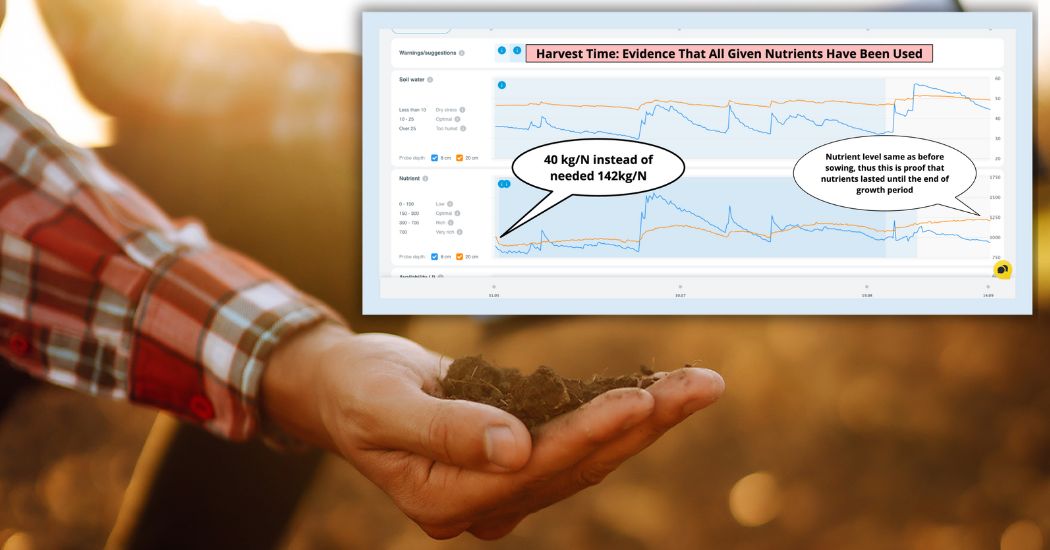Nutrient Use Efficiency (NUE) showcases our crops’ ability to take and utilise nutrients for maximum yields.
As plants venture through the 3 nutrient stages of uptake, assimilation and utilisation of nutrients, we can use precision farming technology to understand the NUE of our crops. The modern farmer with a proper NUE plan in their pocket will likely find:
- Stronger yields and higher-quality crops with increased preservation
- Healthier soil that fights off erosion, poor irrigation and nutrient imbalancing
- Less fertiliser input year-round, and maximum nutrient use from plants
- A decline in input costs, and an increase in profit from harvests
To develop a strong Nutrient Use Efficiency plan, data is needed for calculation. Today we’ll learn a bit more about NUE and how it affects your soil and crop health, showcasing Nitrogen (N) as the primary example/nutrient for context.
Nitrogen Use Efficiency is a relatively simple formula, made better by a complex range of adjustable factors. At its simplest:
| NUE = nitrogen output / nitrogen input |
We’ll also show how to implement simple, precision agriculture tech for developing your own NUE plan.
Understanding NUE and why it matters
Nitrogen Use Efficiency (NUE) calculates how well plants utilise the available nutrients in your soil. Your NUE data will vary, based on the condition of your soil, crops, weather, irrigation and various other factors.
Your crops go through a period known as N cycling which involves the breaking down of plant matter and other materials that host Nitrogen. Once this biochemical change has occurred, N is accessed by the crop, put into use, and eventually returned to its natural state of oxidation. NUE measures the efficiency of N cycling and lets us understand when and how to apply additional nutrients in order to offset nutrient loss, missing nutrients, and the exportation of nutrients through harvest.
It’s possible that you’ll be made familiar with N balance as well. Your N balance shows the numerical potential for loss in unused Nitrogen, but does not show the efficiency at which plants uptake and assimilate it. Nitrogen Use Efficiency prioritises productivity over balance.
| N balance = input – output (potential loss of N) |
| N cycling = process of breaking down and changing N alchemically |
| NUE = Efficiency at which N is used by plants and stored by soil |
When you consider the N balance between input and loss, it’s something we should be able to apply a numerical value to i.e. I have applied x and discovered y remaining at harvest.
Similarly, when we consider NUE, we should apply a percentage value to it i.e. My cereal grains utilise x% of the stored N value, compared to my onions which utilise y%. Of course multiple factors affect NUE other than simply the choice of crop. Discovering the data takes some effort, but…
NUE provides farmers with the action-worthy planning ability they need to resolve irrigation issues, implement better practices with soil tilling, crop choices, efficient fertiliser applications, and provides their soil with the right environment to be naturally healthy all year long. Improper planning for nutrient usage in plants has resulted in N loss becoming the #1 issue worldwide among annual crop farmers. Imbalanced usage of N is now the largest contributing factor in nutrient disorders among global crop yields.
? Fact: The global, natural recovery of N in crops is < 50% leading to higher input costs worldwide and a dramatic increase in pollution through inefficient fertiliser usage, run-off and misapplication. Even 25 years ago, it’s estimated that U.S. farmers lost an estimated $15.9 billion in N fertiliser through poor soil sustainability and poor crop NUE.
Your soil is your crop’s primary source of N. It’s why having an NUE plan is a necessary and sustainable practice that always pays off.
The 2 primary factors affecting Nitrogen Use Efficiency (NUE)
- Ensuring soil health: preventing nutrient loss through run-off, drainage water, sediment movement (erosion) and leaching
- Optimising crop nutrient intake: enabling plants to take stored nutrients from the soil as they need and use them wholly
Data is invaluable to any modern farmer, and unavoidably so when developing and implementing a proper NUE plan. Knowing how to access your soil and crop data on a constant basis will be the difference between joining a global statistic of unnecessarily high input costs and lower yields, or maximising your harvests while enabling your farm to have healthier, sustainable soil and crops year-round.
Your soil’s make-up is vital for your plant’s to steadily uptake nitrogen. Water-logged, parched or coarse soil can prohibit proper root growth, as plants extend their network to discover nutrients. Taking care to ensure your soil is healthy will result in a better storage system for nutrients, including nitrogen, and less applications of additional fertilisers by default. By increasing the space in which roots can grow, natural biomatter availability increases after harvest alongside it.
Your crop’s ability to intake and process nutrients is the second key factor in a farm’s NUE cycle. The N cycling of plants varies by type and environment, but other nutritional (and treatable) factors come into play more often than naught.
? Fact: In the UK, Yara states that “Zinc deficiency has one of the greatest impacts with studies revealing it reduced the metabolism of nitrogen by 50%. Manganese, copper and molybdenum deficiency have all been shown to have a negative impact on nitrogen metabolism and therefore nitrogen utilisation efficiency.” The effects of these deficiencies among UK arable farms specifically stand out.
Our crop’s NUE understanding can best be calculated by our constant comprehension of their active hydration levels and multi-nutrient capacities.
Nitrogen Use Efficiency should not be considered a means to an end. Your ability to measure, monitor and adjust NUE based on crops, environmental factors, longer-term weather patterns and other changes will make a considerable difference in the overall health and output of your farm.
Signs that your NUE calculations may be wrong
Calculating a proper plan for nutrient use and fertiliser applications won’t always be a perfect play up the pitch the moment you begin. Utilising proper equipment to nail down your precision farming techniques will greatly increase your success rates, but human error and unforeseen environmental changes may crop up from time-to-time.
Possible signs that your NUE plan could use some adjusting include:
- Dry-zones in farming where plants and soil remain under hydrated, or where soil is oversaturated.
- An excessive amount of leftover nutrients following crop harvest.
- Dramatic declines in N values during the growing season, not correlated to N cycling.
- Total lack of N levels (or severely low) during planting and harvesting.
Choosing proper cover crops, fertilisers and calculated applications of them, irrigation techniques and adjustments, are just a few ways in which we can evolve our NUE plan around the changing needs of our crops.
Benefits of implementing an NUE plan
While healthy soil and stronger crops may speak for themselves, the benefits of NUE practices go beyond their foundation and harvest.
We’ve seen how large-scale farms like Uussaari in Finland were able to use Paul-Tech and a proper NUE plan to reduce their fertiliser use by 70% and come out of harvest with a more efficient, stronger yield. To quote the owner Aleksi:
“Having data from my soil was crucial in understanding how our actions affect the growing environment. We used data from Paul-Tech to determine the amount of unused nutrients in our soil, and when adding additional nutrients would be ineffective.”
With first-hand data and the hands-free ability to monitor changes in real-time, modern farmers are able to utilise precision ag-tech more easily than ever. The results tend to speak for themselves when rapid implementation and adaptation are achieved:

- Higher yields and stronger crops at harvest
- Stronger roots, weather-resistant, increased biomatter
- Less input, more precision in usage of fertilisers
3 overlooked pros to Nitrogen Use Efficiency planning
- Proper NUE plans teach us to utilise more nutrient resources like leaf matter, stubble and root biomass, often increasing our natural nutrient sources
- Soil structure can be strengthened by preventing dry zones, erosion and run-off through better irrigation and moisture content comprehension
- Leaching less nitrates into the groundwater and losing even fewer through denitrification is a major environmental pro, reducing fertiliser creation, transport and waste
3 reasons to choose Paul-Tech for real-time NUE data
Farming has long-been a generational handing-down of knowledge, techniques, equipment and passion. Our team at Paul-Tech believes in a combination of conventional wisdom with tried-and-true science. We’ve discovered this formula leads to some pretty spectacular results in the field.
That being said, the adoption of new techniques isn’t always easy. It’s why we’ve designed Paul-Tech soil stations to be easy to install, self-charging, autonomous units that deliver easy-to-read charts, data and personal recommendations to any farmer. If you’re considering NUE in your farming practices, Paul-Tech soil stations provide the most accurate data you need in real-time.
Perhaps you’re considering giving ag-tech and precision farming a go, but naturally worry about the common challenge of:
“I can’t afford to invest in a bunch of equipment and extra time”
With so much out on the market, it’s definitely difficult to garner an understanding of exactly what you may need or want to adopt. The potential shopping cart can be overwhelming when viewed as a whole.
It’s important to get the best bang for your buck when choosing ag-tech. For this reason, our soil stations combine satellite, weather and in-ground soil nutrient and moisture probes to elicit the most data from your fields as possible with real-time, pin-point precision.
“I’m hesitant when it comes to adopting new technology before testing”
We’d encourage you to start with a free demo before you get going with any solution. Adopting new technology can be scary, given the time and financial investment associated with it.
Because we believe in our research as well as your own, you’re encouraged to check out our updated case studies to see how Paul-Tech soil stations are making €100,000 differences for some farmers in our home region, and how implementing soil stations on your farm can make a big difference.
You can book a hassle and cost-free demo with our Paul-Tech team in minutes.
“There are so many options out there for farming solutions”
Developing a Nitrogen Use Efficiency plan, understanding your field’s dry zones, monitoring crop and soil health, and reducing your input costs year-round all fall under one roof in ag-tech: Data.
We’re confident that Paul-Tech soil stations provide more data than any other solution available, and do so consistently. Our friendly team is excited to help you set up, monitor and get the most out of your small investment in a big future with Paul-Tech.
Start with a free demo, and let our team show you how a few solar-powered soil stations can make an instant difference on your farm: financially and naturally.


